It may be cold outside but inside the family kitchen is warm with the aromas of this Vegan Chicken Stew and Dumplings bubbling away to tasty homely perfection. This stew is so easy to come together in one pot, and can be ready in just over an hour. Its packed with hearty veggies cooked in a creamy sauce and enriched with airy, soft, melt-in-the-mouth dumplings. This veggie stew will quickly become a staple on your family menu as its so versatile - use whatever veggies you love and have to use up.
Want to prepare in the slow cooker? We have provided an easy slow cooker method in the useful recipe notes.

Our vegan no-chicken stew can be safely dished up to those meat eating members of the family as the chicken will absolutely not be missed and it is an example of delicious traditional plant-based cooking! Serve along with lots of crusty bread for mopping up all the tasty veggie white gravy!
Jump to:
📜 Origins of chicken stew 🌍
Chicken stew originated thousands of years ago and most countries around the world have their own variations. It is difficult to track down the actual origins of the first chicken stew as humans have been preparing stews for thousands of years. Possibly the first recorded stew was within the ancient Roman cookbook 'The Art of Cooking' by Apicius which dates back to the 4th century!
Chicken soup, which is similar to chicken stew, dates back even further to 7000-10000 years ago to somewhere in India or South Asia. Again chicken soup has countless variations that can be found around the world. The history of chicken stew and chicken soup are intertwined as both dishes are so similar.
In European cultures, particularly British and French, stews have been a staple for centuries. The French have their "Coq au Vin," a dish where chicken is slow-cooked with wine, mushrooms, and other vegetables. The British have a long tradition of meat stews and pies, such as chicken pie, which is usually filled with chicken and root vegetables like potatoes, carrots, mushrooms, in a creamy sauce much like the ingredients you'd find in a traditional chicken stew today.
In the US, chicken stew has some regional differences, such as the family favourite chicken and dumplings of the Southern states, a comfort food meal that became especially popular during the Great Depression for its ability to stretch ingredients.
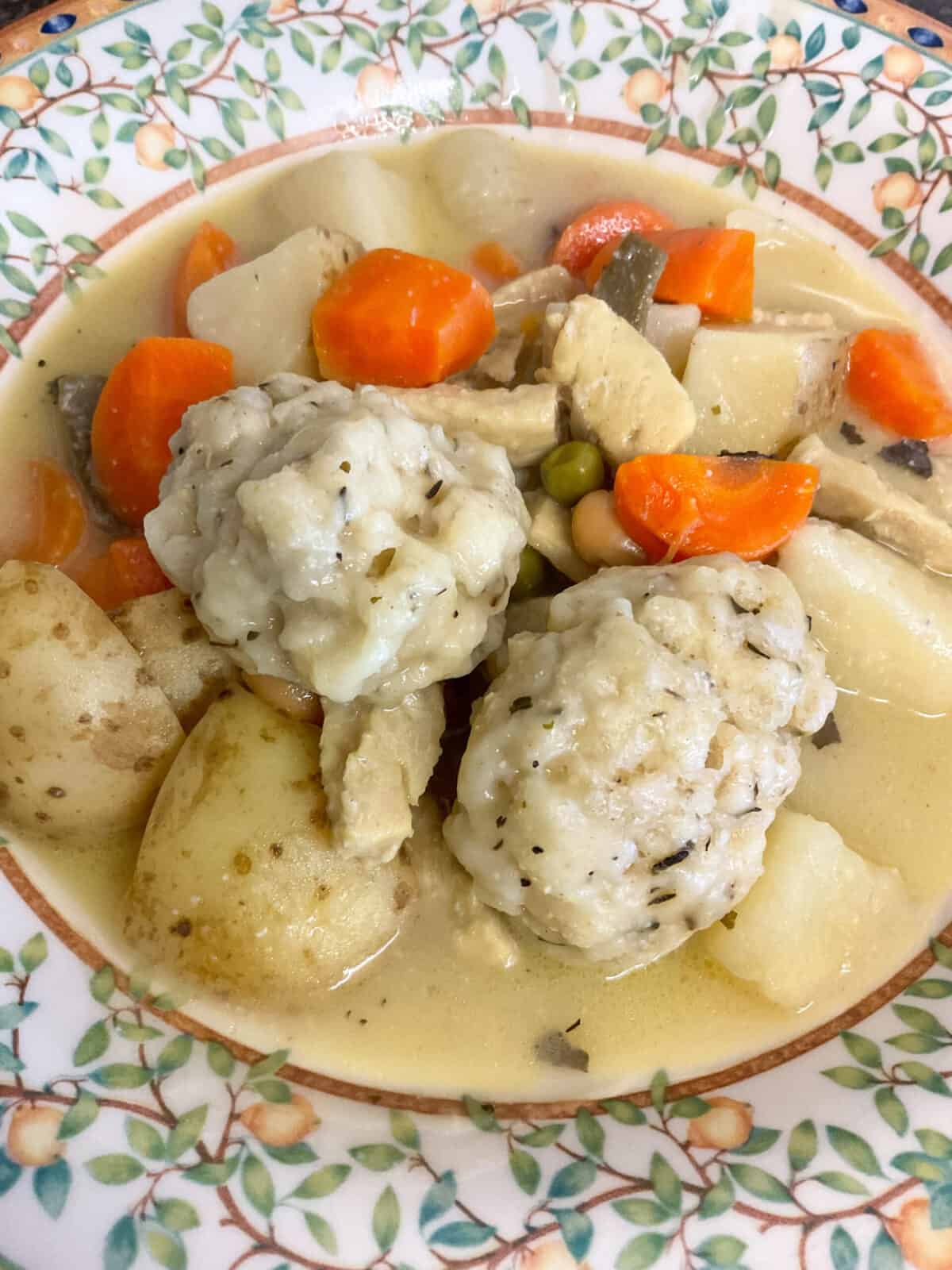
You can prepare this vegan no-chicken stew using our vegan mayonnaise dumplings which are detailed with the recipe card below, or go the more traditional route and prepare vegetable suet dumplings. The stew above was prepared with tasty veggie suet dumplings.
Chicken stew also has variations around the world. For example, in Africa, such as the Nigerian chicken stew and the Ethiopian ''Doro Wot''. traditional African chicken stews are often spiced with a mixture of herbs, spices, and flavoured with tomatoes and bell peppers, and sometimes even peanut butter.
Latin American countries have their own versions, such as the ''Pollo Guisado'' which is a chicken stew prepared with ingredients such as potatoes, carrots, onions, tomatoes, bell peppers, and various herbs and spices.
Throughout history, stews were often considered "peasant food" because they could be made in one pot and were a way to use up various ingredients that were readily available.
During times of war and economic hardship, like the World Wars and the Great Depression, stews were a practical way to use up rations and cope with food shortages. Chicken, being more budget-friendly and more easily accessible than other meats, was commonly added to stews.
🍽 More vegetable stew recipes
For even more tasty vegan, plant-based, and vegetarian stew recipes do check out our family collection of Vegan Stews and Casseroles.
🍲 What's the difference between a stew and a soup?
The difference between a soup and a stew can be subtle, but there are some key differences that set them apart:
Both soups and stews involve cooking ingredients in a liquid, such as a broth, stock, gravy, milk, or even wine, beer, or cider. However, the thickness of the liquid and how the stew is presented is what can set a soup and a stew apart.
Stews generally feature chunkier and thicker ingredients sometimes referred to as a ''peasant cut''. Hearty vegetables and proteins such as beans or meat, are densely packed into the stew liquid. This density is often enhanced through the use of thickeners like flour, cornstarch or cornflour, or potato flour. On the other hand, soups may have a more varied range of consistencies, from clear broths to creamy textures, but are generally not as packed with ingredients as stews.
Another significant difference lies in how they are served. Soups are typically served in bowls to accommodate their more liquid consistency. Stews, however, can be versatile in their presentation. Due to their thicker texture, they can be served not just in a bowl, but also on a plate, accompanied by sides like bread, rice, or mashed potatoes, with the thick gravy poured over.
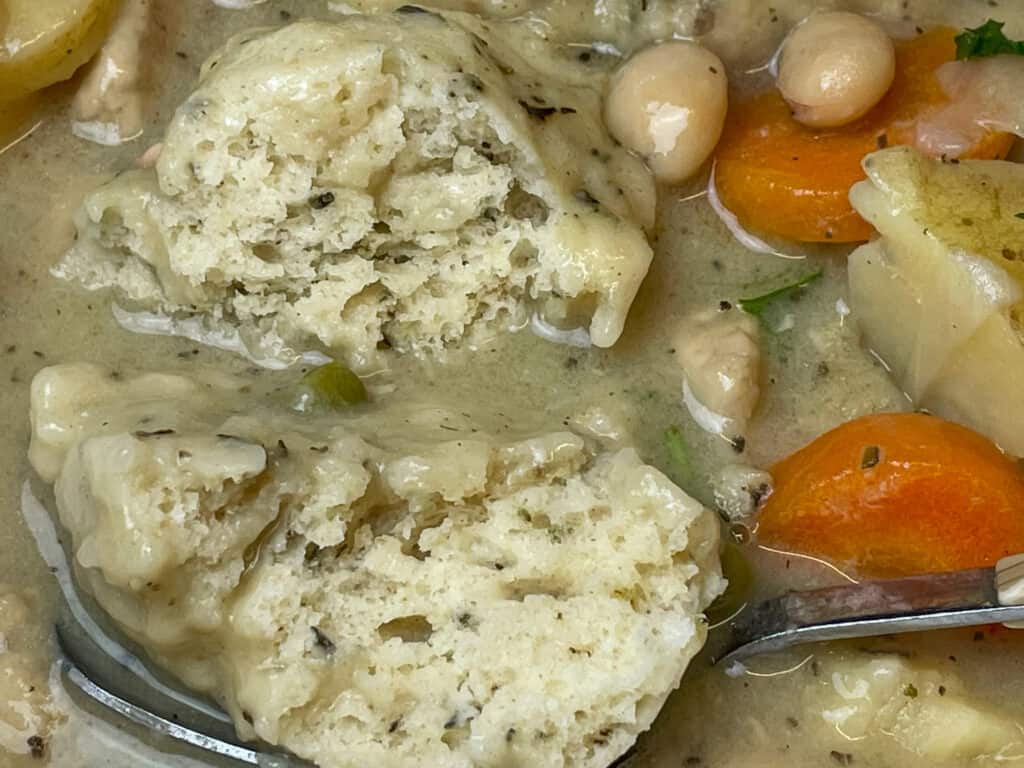
These suet-free dumplings are amazingly fluffy, airy, and light, and are just incredible soft pillow-like dumplings!
🔪 How To Prepare
For this veggie stew you can saute the vegetables in either oil or a small amount of vegetable stock. We use traditional stew vegetables - potatoes, parsnips, carrots, celery, and onions - for our meat-free stew but these can be replaced with whatever vegetables you prefer or have to use up.
A frozen casserole mix is a good budget-friendly idea and it is also a great time saver as it also means that you won't need to chop up the veggies!
We like to use Quorn vegan pieces for our stew but again you can use whatever meat-free chicken you prefer or omit and use mushrooms or extra beans instead.
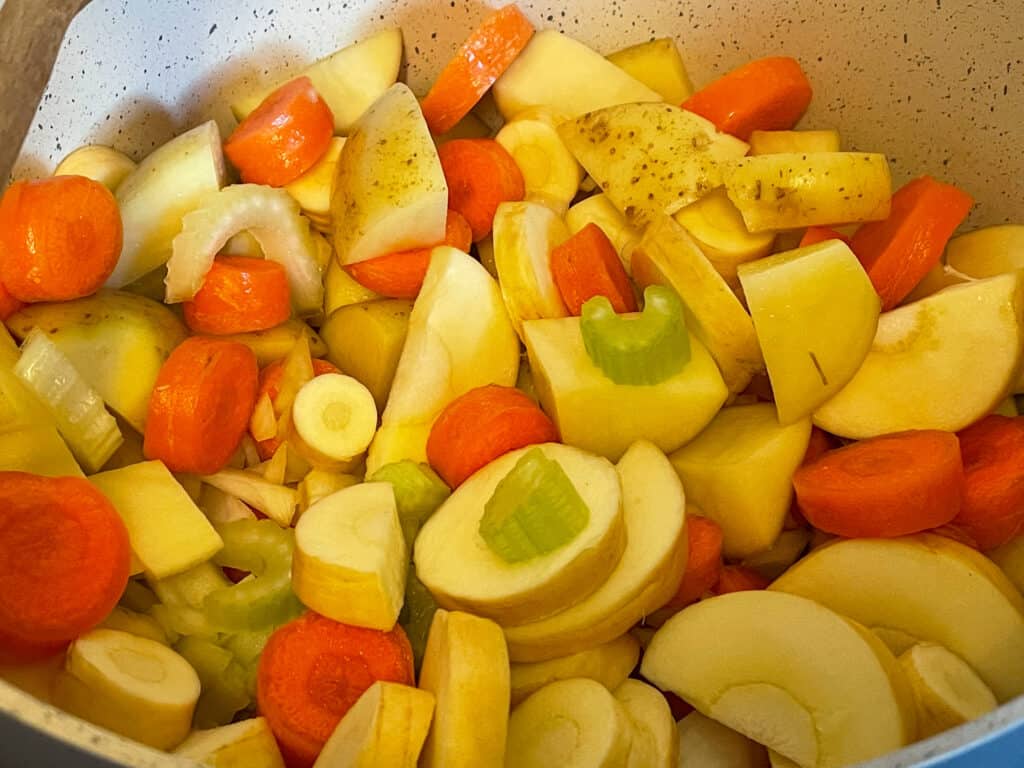

Step 1: Heat the oil or veggie stock in a non-stick large saucepan or Dutch oven pot. Add the potatoes, parsnips, carrots, celery, onions, garlic, and meat-free chicken pieces. Sauté for 8 minutes stirring regularly.

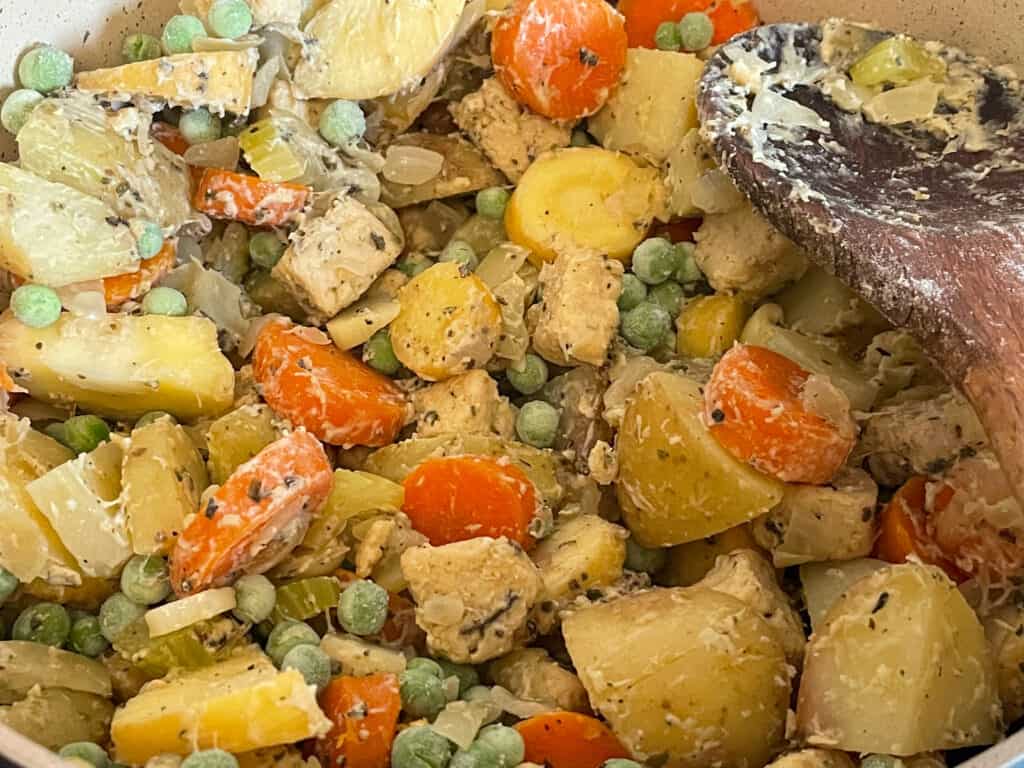
Step 2: Mix through the dried sage, flour, peas, and beans. Season with salt and pepper.


Step 3: Pour in the vegetable stock, stir well, and bring to a gentle boil. Cook for 20 minutes, stirring a few times.
Step 4: Meanwhile prepare the dumplings. Add the flour, vegan mayonnaise, plant-based milk, and dried thyme to a mixing bowl. Season with a few good pinches of salt and black pepper.
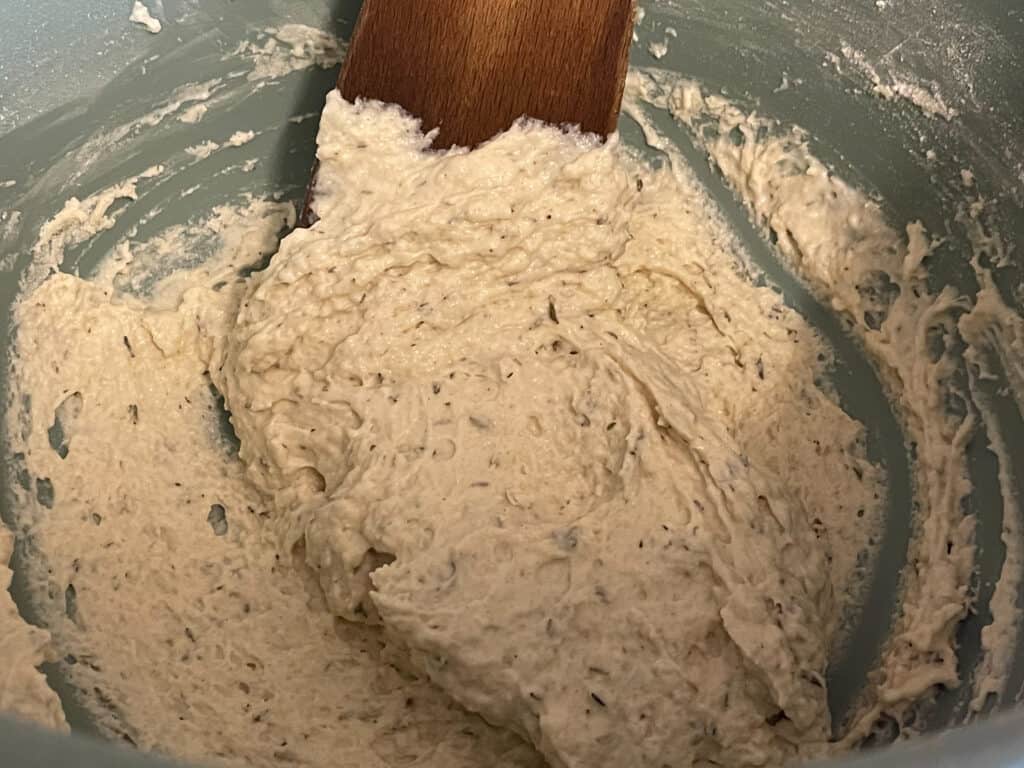

Step 5: Mix well into a thick, sticky dumplings batter.
Step 6: After 20 minutes of the stew cooking pour in the coconut milk, stir and bring back to a gentle boil.
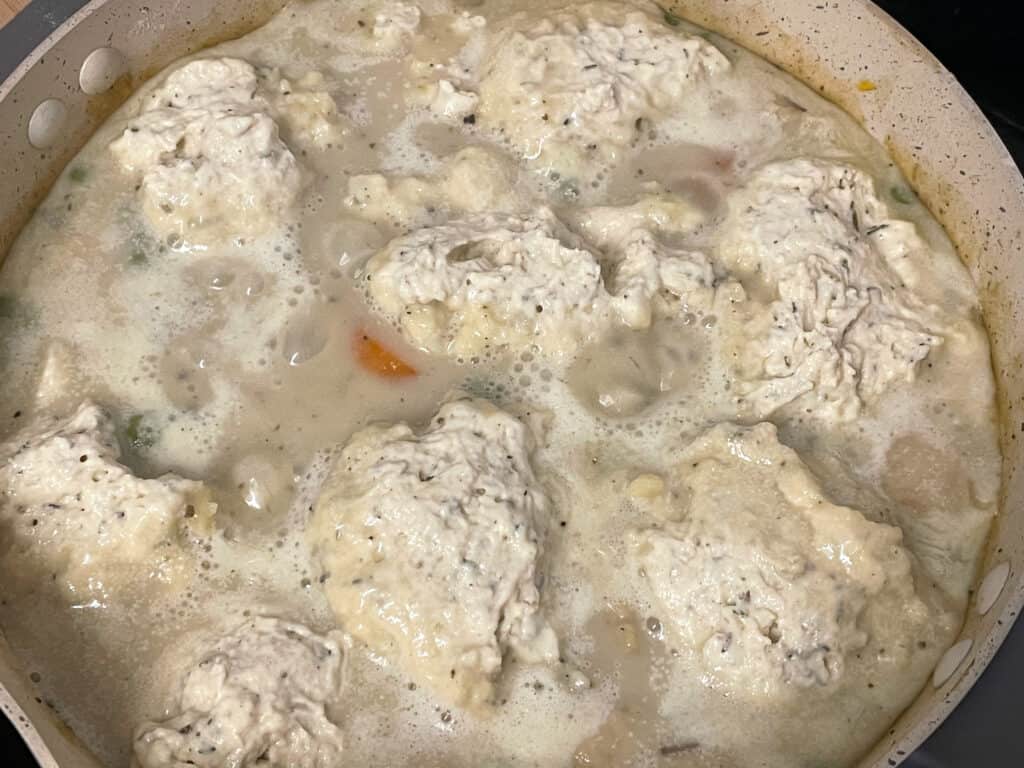

Step 7: Use an ice cream scoop of a large spoon drop 8 dumplings into the stew.
Step 8: Pop a lid over the pot and cook the dumplings for 20 minutes.
Step 9: After 20 minutes switch off the stove top but leave the pan to sit for an extra 10 minutes with the lid on the pot.


Step 10: The tasty stew is now ready to serve.
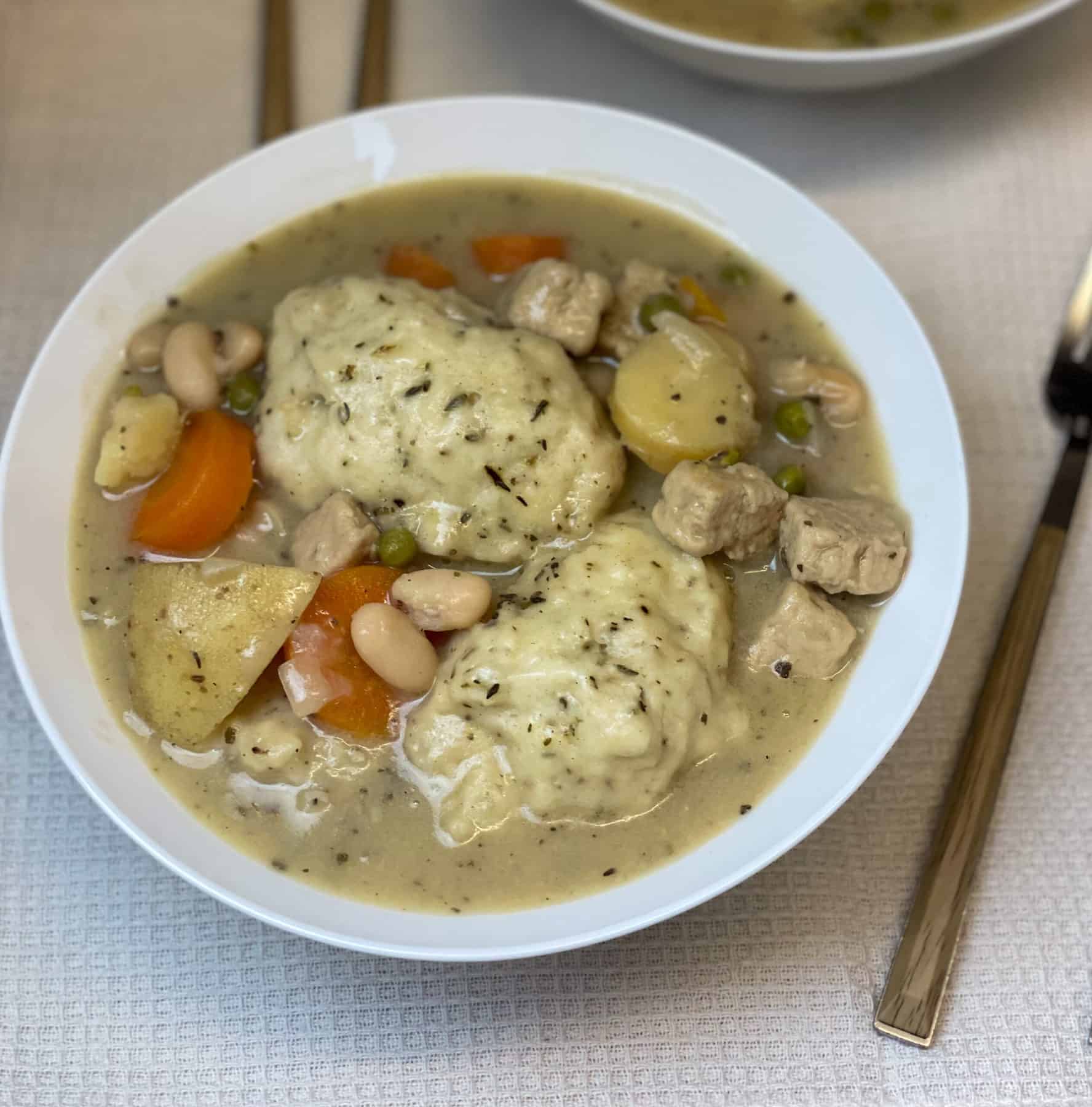
Don't forget the parsley (like I did for this photo!) It really is tasty with this creamy sauce! Or you can omit the parsley and perhaps use your favourite fresh herb instead.
🧾 Recipe notes
⏲️ Storing
Leftover stew can be stored in the fridge for up to 3 days within a covered container. Or frozen for up to 3-4 months. Thaw completely before reheating.
♨️ Reheating
Place the stew into a non-stick pot and bring to a gentle boil, reheat for 2-3 minutes or until piping hot throughout. Stir frequently while simmering. A little extra milk or vegetable stock may need to be added as the stew will likely have become thicker, but it will thin out more as it reheats.
📋 FAQ'S
The stew can be prepared as gluten-fee with a few changes. Use gluten-free plain flour (we like to use the Doves Farm Freee plain flour to thicken sauces or stews and also ensure that your vegetable stock is gluten-free. If you are using vegan chicken pieces then also make sure that those are also certified gluten-free.
For gluten-free dumplings you can try this gluten-free herb dumpling recipe over on coeliac.org.uk.
Yes, preparing stews in the slow cooker is always a good idea! Follow this simple guide to adapt the main veggie stew recipe from the stove-top to the slow cooker:
1. Reduce the vegetable stock to about 900-1000 millilitres [4 - 4 ½ cups]. If the stew appears too thick, you can always add more stock later and if its too thin you can thicken up with a cornstarch [cornflour] slurry.
2. Add all your vegetables and vegan chicken pieces to the slow cooker along with the flour and seasonings. You can either sauté the vegetables beforehand for added flavour or just throw everything. Pour in the hot vegetable stock.
3. Cook on the high setting for about 4 hours, or low for 7-8 hours, but exact times will vary depending on your slow cooker.
4. Once the vegetables are soft, stir through the coconut milk, check the seasoning and add salt and pepper to taste, and pop the lid back on the slow cooker as you make up the dumpling mixture [if your cooker is set to low switch it up to the high setting].
5. Drop the dumplings into the slow cooker and cook on high for 30 minutes.
6. Flip the dumplings over and cook for a further 30 minutes or until cooked.
7. Once the dumplings are airy and no longer doughy in the middle, the stew is ready to enjoy. Garnish with chopped parsley, if liked.
For another veggie stew slow cooker recipe do have a look at our Vegan No-Beef Stew and Dumplings recipe.
Any vegan no-chicken style pieces or chunks can be used for this recipe and they can be either fresh or frozen.
Or you could add seitan, tempeh, tofu, canned jackfruit, or dried soy curls that have been rehydrated.
Alternatively, mushrooms would be especially tasty, as would simply adding extra veggies or canned white beans to the stew.
Yes of course, feel free to switch out any of the vegetables for ones that you prefer or already have to use up. If you have canned potatoes you could always use those as they are quite tasty cooked in a white creamy sauce.
Absolutely, you can switch out the dried herbs for whatever fresh herbs you prefer and have easy access to.
Yes you can replace the canned milk with one of the following:
1. Silken tofu blended until smooth.
2. Cashew cream prepared with soaking cashews in hot water and then blending the nuts on a 1:1 ratio of nuts: fresh water, until as smooth as your blender allows!
3. Unsweetened soy or almond creamer.
4. Coconut cream is thicker than canned coconut milk but it could be diluted with some water or vegetable stock.
5. Vegan cream such as Alpro single soya cream or Oatly oat cream cope well with cooking and can replace the coconut milk.
This vegan stew is hearty and filling on its own, making it a complete meal that doesn't necessarily require additional sides. However, if you're serving bigger appetites, there are a few classic accompaniments that pair well.
For a comforting, homey touch, consider serving the stew with a slice of Irish soda bread made from 100% wholemeal flour. Or a wedge of your favourite crusty bread such as our Australian Damper Bread or some traditional Scottish oatcakes for a nice crunch. Saltine crackers are another nice side.
Alternatively, serve the stew over a grain as this can add another hearty layer of texture and flavour. Barley or whole-grain rice offers nutty pleasant flavour, while wheat grains or millet can provide a softer texture. Or try a different grain such as Farro, quinoa, rye grains, or even teff.
Other tasty accompaniments are mashed veggies such as a vegetable mash prepared with either/or a mix of - turnip, swede, rutabaga, celeriac, cauliflower, sweet potato, butternut squash, carrot, etc. Or if you switched out the potatoes for a different veggie you could have mashed potatoes.
Yes, we have an easy vegetable suet dumpling recipe over on our Traditional Vegetable Stew and Dumplings post, that work very well with this recipe as we have recently prepared the stew with our suet dumplings.
The image below is off our vegan chicken stew prepared with suet dumplings:
No, the dumplings in this vegan chicken stew and dumplings are not the same as Chinese dumplings.
Our vegan dumplings are similar to traditional British or American-style dumplings often found in stews or casseroles. They're usually made from a simple dough of flour, baking powder, and some form of fat, oil, or suet, which is then dropped into a simmering stew to cook. The vegan mayonnaise used in our dumpling recipe replaces the fat or suet. These types of dumplings are designed to be soft, fluffy, and absorbent, soaking up the delicious flavours of the stew.
Chinese dumplings, on the other hand, usually consist of a filling which is often made of meat, vegetables, beans, herbs and spices and wrapped in a thin dough wrapper. These are commonly steamed, boiled, or pan-fried. The dough is usually made with a mixture of flour and water, and sometimes egg. The focus here is often on the filling, with the dough wrapping holding it all together.
The terms "dumpling" and "doughball" can sometimes be used interchangeably, but they generally refer to slightly different things, especially in traditional British cooking.
A dumpling, in British cuisine usually means a ball of dough that's added to a stew or casserole. Traditionally, these are made with suet and flour and sometimes include herbs or spices for extra flavor. They're meant to be light and fluffy, absorbing some of the stew's flavours as they cook.
Doughballs, on the other hand, are often denser, heavier, and chewier than dumplings. They're usually served along with pizza rather than stew. For example, you might find doughballs served alongside pizza or pasta, often seasoned with garlic or herbs and perhaps served with a dipping sauce.
However, the terms can vary depending on where you live in the UK, as regional dialects and family traditions vary. Some might call a suet dumpling a "doughball" out of habit or because that's what their family called them.
💭 Four top tips
- For extra fluffy dumplings be sure not to overmix the dumpling batter as overmixing can lead to the development of gluten, making your dumplings tough rather than light and airy. The ingredients only need stirred until they are just mixed. For better control over the mixing its also best to mix by hand with a mixing spoon rather than a cake mixer.
- Season as you cook and don't wait until the end to season your stew. Adding small amounts of salt, pepper, and herbs at several stages throughout cooking helps to build up the layers of flavour. Doing so will ensure that your stew is perfectly seasoned.
- Control your heat as you cook as by paying close attention to the cooking temperature, especially when simmering the stew and cooking the dumplings. A gentle, steady boil ensures that the flavours meld together well without overcooking the vegetables or evaporating too much of the liquid. A gentle boil also helps the dumplings steam to fluffy perfection.
- If you don't have fresh onion or fresh garlic then use their ground counterparts as garlic powder and onion powder are particularly tasty in a creamy stew. Also to build extra depths of flavours you could even use both the fresh and ground varieties.

⭐ More vegan 'no-chicken' dinners
Disclaimer: None of our vegan 'chicken' recipes contain any actual chicken! We often get messages asking this question so thought we should clarify!
Instead they are flavoured with vegan-friendly chicken-y flavours and instead of chicken they are prepared with delicious all veggie ingredients!
We think ingredients such as potatoes, chickpeas, vegan Quorn pieces or other meat-free no-chicken chunks, soy curls and textured vegetable protein [TVP], creamy white beans such as butterbeans, amongst countless more tasty vegetable ingredients, are so much tastier than actual chicken, so are perfect for vegan no-chicken recipes.
As more and more people migrate over to the plant side they do enjoy the comforting familiarity of the traditional family favourites that they once knew so having a vegan version just makes sense.
Below are a few more vegan 'no-chicken' dinners that our family particularly loves - This Vegan 'chicken' Pie which has potatoes, mushrooms and vegan chicken pieces, and this Vegan 'chicken' Coriander which features tasty chickpeas, and this Vegan 'chicken' Noodle Soup which is prepared with delicious vegan Quorn chunks, and this Vegan Mango 'chicken' Curry which features potatoes and chickpeas.
If you are not a fan of vegan chicken chunks then feel free to switch those out for more veggies as our family recipes are very versatile.
***please note: for US measurements click the 'US customary button' within the recipe and the measurements will switch to tablespoons, cups, and ounces.***
📖 Recipe
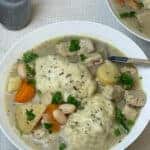
Vegan Chicken Stew And Dumplings
Equipment
- Large non-stick stew pot or Dutch oven with lid
- Mixing bowl
Ingredients
Stew:
- 1 tablespoon olive oil [or ½ (125ml) cup vegetable stock, use more stock as required]
- 200 grams vegan Quorn pieces [or similar alternative, or use an extra can of white beans]
- 1 can cannellini beans [or butterbeans, 400g (14oz) can, drained, or 240g cooked beans]
- 230 grams parsnips [about 2, sliced into thick chunks]
- 230 grams carrots [2 medium, thick sliced into chunks]
- 65 grams celery [1 large stalk, sliced into small chunks]
- 400 grams potatoes [3 small, diced into chunks]
- 130 grams peas [frozen, fresh, or tinned]
- 200 grams onion [1 large, diced or thick sliced]
- 4 cloves garlic [sliced, use more if preferred, or replace with 1 tablespoon garlic granules]
- 2 tablespoons plain flour [or all purpose flour, gluten-free plain flour, plain wholemeal or wholewheat flour]
- 1 can coconut milk [400ml (14oz) can, use a lite coconut milk for less calories and fat, but full fat will result in a creamier stew]
- 1.2 litre vegetable stock [hot, use a vegan chicken stock, cubes, bouillon etc, if available]
- 2 teaspoons dried sage [or dried thyme or dried mixed herbs]
Dumplings:
- 165 grams self raising flour [or plain or all purpose flour with 1 ½ teaspoons of baking powder, and a few pinches of salt]
- 125 millilitres plant based milk [such as oat or soya, or your usual milk]
- 2 tablespoons vegan mayonnaise [heaped tablespoons]
- 1 teaspoon dried thyme [or dried mixed herbs]
To serve: [optional]
- 10 grams fresh parsley [fine chopped]
Instructions
- Heat the oil or veggie stock in the pot.1 tablespoon olive oil
- Add the onion, celery, carrot, parsnip, potato, garlic, and vegan pieces, and sauté for 8 minutes over a medium heat. Give it a stir every now and again.200 grams vegan Quorn pieces, 230 grams parsnips, 230 grams carrots, 65 grams celery, 400 grams potatoes, 200 grams onion, 4 cloves garlic
- Stir through the flour, peas, beans, and sage. Sprinkle in some salt and pepper and give it all a good mix.1 can cannellini beans, 130 grams peas, 2 tablespoons plain flour, 2 teaspoons dried sage
- Pour in the vegetable stock and bring to a gentle boil.1.2 litre vegetable stock
- Simmer for 20 minutes with the lid off, stirring every now and then.
Meanwhile prepare the dumplings:
- Add the flour, thyme, milk and mayonnaise to a mixing bowl, along with some salt and pepper and mix well to combine into a thick, sticky batter.165 grams self raising flour, 125 millilitres plant based milk, 2 tablespoons vegan mayonnaise, 1 teaspoon dried thyme
Add dumpling mix to stew:
- After 20 minutes has past, check the stew seasoning and add extra salt and pepper if required. Pour in the coconut milk and bring back to the boil.1 can coconut milk
- Scoop 8 even size dumplings and drop into the stew a little away from each dumpling so that they don't stick together.
- Pop a lid on the pan, turn down the heat so that the stew is at a steady low boil, and cook the dumplings for 20 minutes.
- Turn off the heat and allow the pan to sit on the cooker ring for another 10 minutes.
- Serve the stew and dumplings with chopped parsley scattered over each serving.10 grams fresh parsley
Notes
- Nutritional information is provided for guidance only and is not a strict calculation as ingredients vary.
- Leftover stew can be kept in the fridge, within a covered container, for up to 3 days.
- Or frozen for up to 3-4 months.
- Reheat leftover stew by adding to a pan along with some extra plant-based milk, veggie stock or water, if necessary, as the stew will likely become very thick as it sits. Bring to a gentle boil and reheat for 2-3 minutes until everything is piping hot. Stir frequently.
- Leftover stew is delicious mashed up or blended and enjoyed as a vegan chicken soup for next days lunch. Stir through some vegan cream before serving for a delicious vegan cream of chicken soup.
- Want to prepare vegetable suet dumplings instead? We have an easy recipe over on our traditional vegetable stew and dumplings post.
- The vegan Quorn pieces can be replaced with any fresh or frozen vegan meat-free pieces or chunks, seitan, tempeh, tofu, or hydrated soya curls, or mushrooms, extra white beans, or extra veggies or potatoes.
- Slow cooker method:
- 1. Reduce the vegetable stock to 900-1000 millilitres [4 - 4 ½ cups]. If the stew appears too thick, you can always add extra hot stock later and if its too thin you can thicken up with a cornstarch [cornflour] slurry.
2. Add all your vegetables and vegan chicken pieces to the slow cooker along with the flour, and seasonings. You can either sauté the vegetables beforehand for added flavour or just throw everything in -your choice. Pour in the hot vegetable stock.
3. Cook on the high setting for about 4 hours, or low for 7-8 hours, but exact times will vary depending on your slow cooker.
4. Once the vegetables are soft, stir through the coconut milk, check the seasoning and add salt and pepper to taste, and pop the lid back on the slow cooker as you make up the dumpling mixture. [if your cooker is set to low switch it up to the high setting]
5. Drop the dumplings into the slow cooker and cook on high for 30 minutes.
6. Flip the dumplings over and cook for a further 30 minutes or until cooked.
7. Once the dumplings are airy and no longer doughy in the middle, the stew is ready to enjoy. Garnish with chopped parsley, if liked.
Nutrition
💬 Comments
Prepared our Vegan Chicken Stew and Dumplings? We would love to know how you got on with the recipe as it helps us to know if we are on the right track!
All our recipes are what we eat on a day-to-day basis so its great knowing that others love them too or perhaps have some constructive criticism.
So it would be wonderful if you could drop us a comment below and click the star ratings. Thanks so much, Jacq x


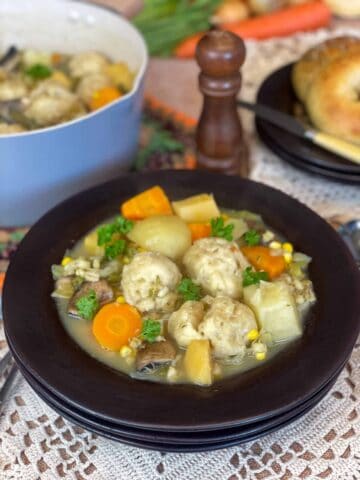

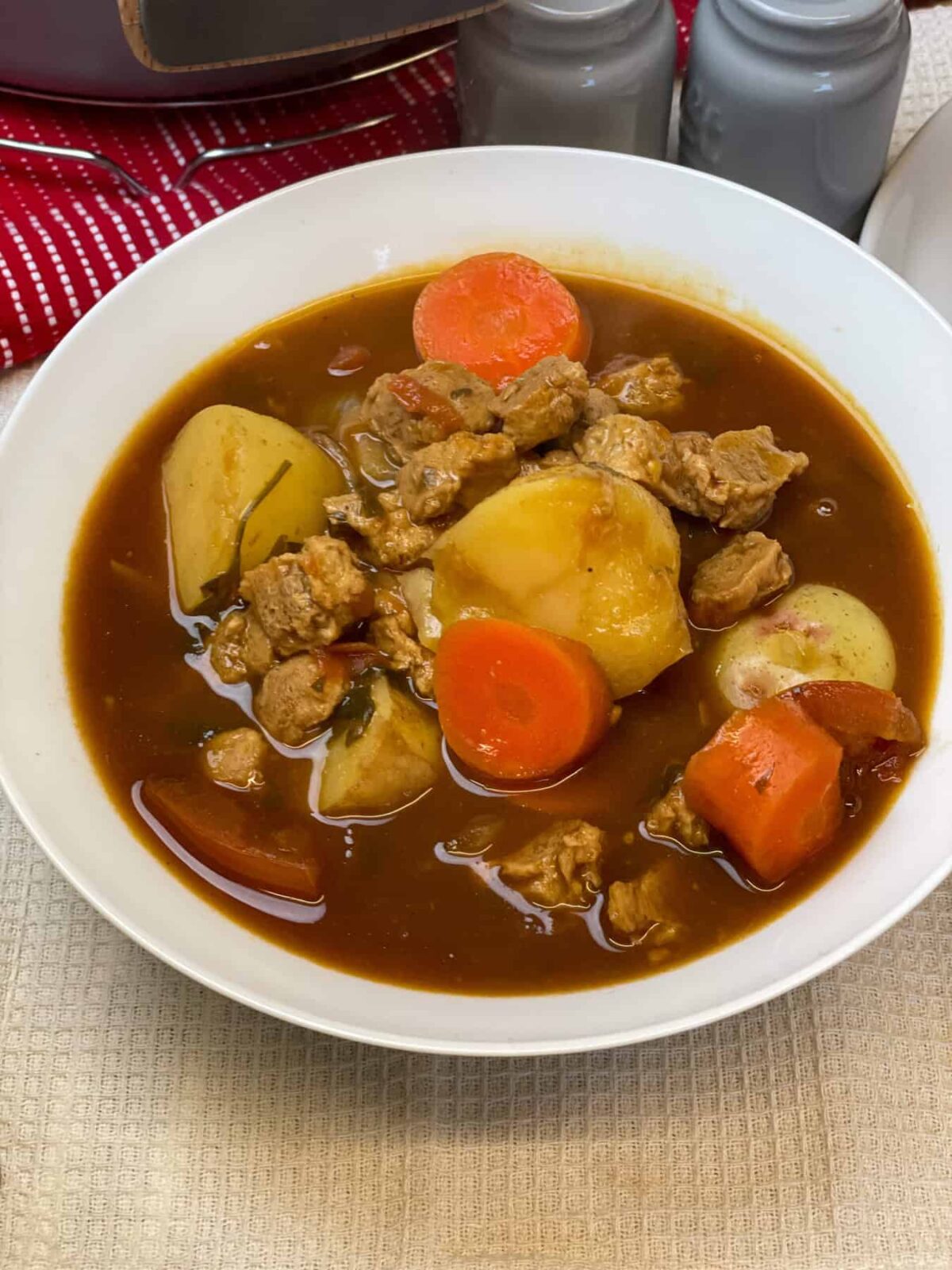
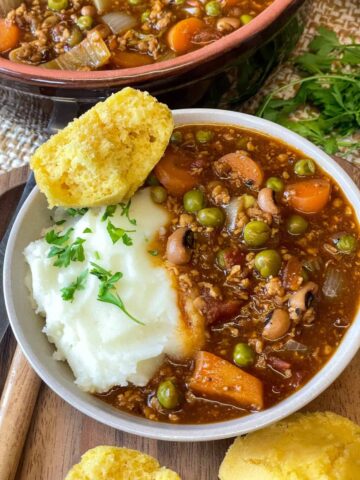
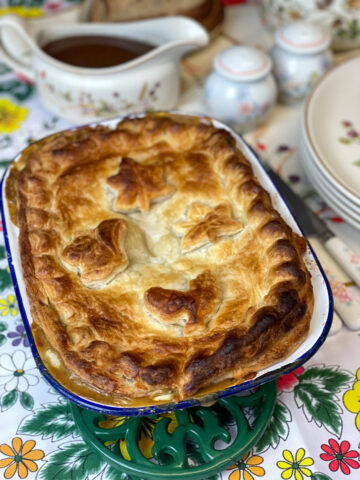
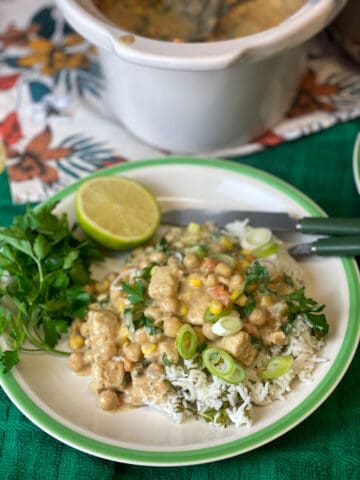
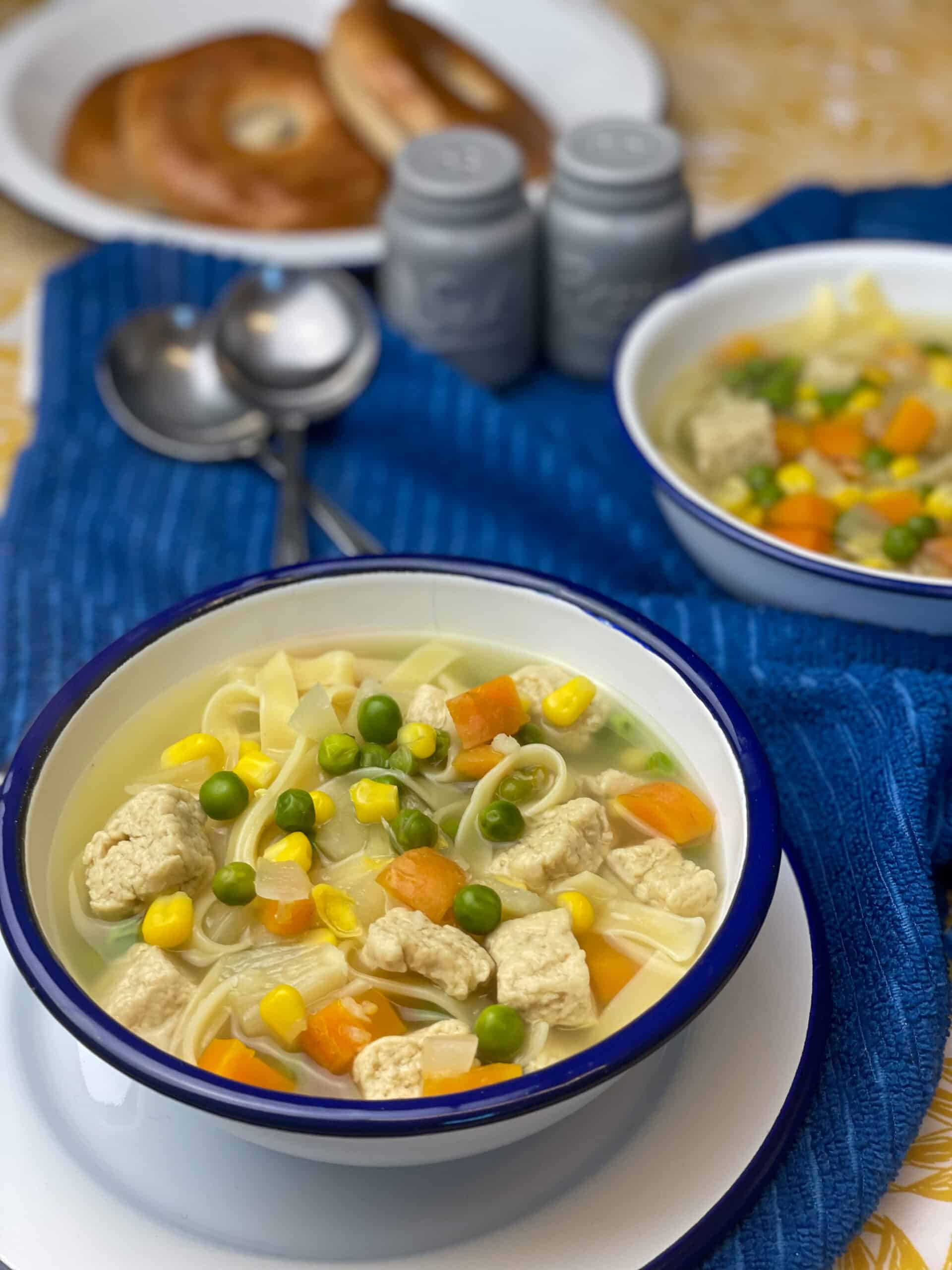
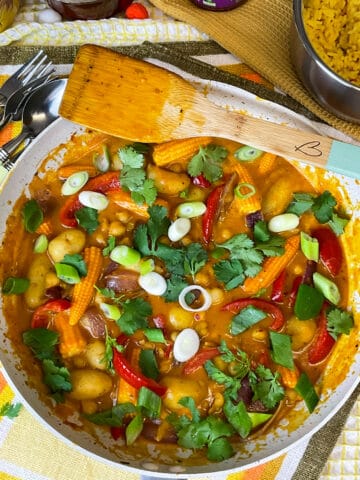
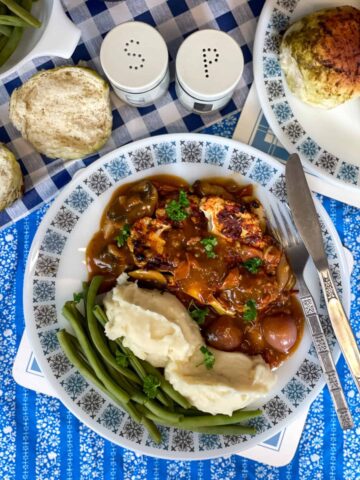
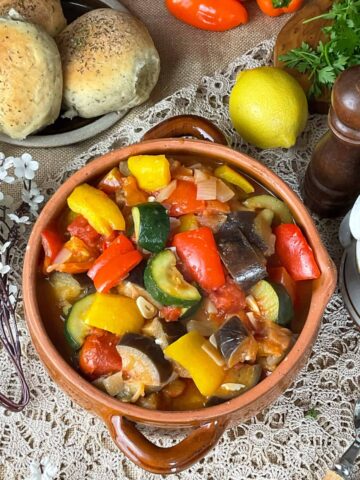
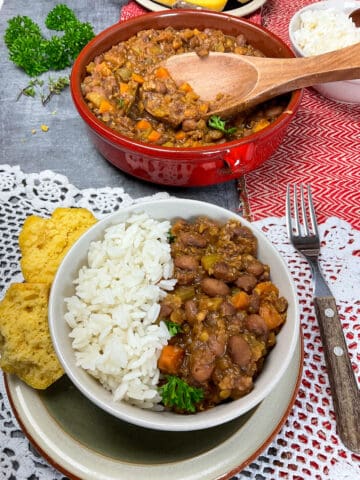
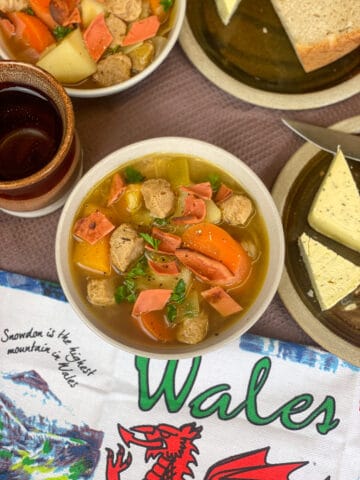
Leave a Reply